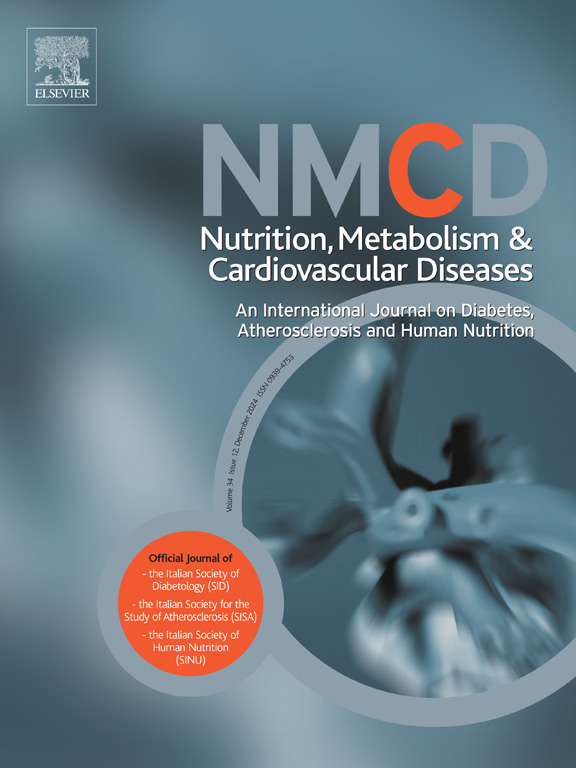Association between remnant cholesterol and arterial stiffness: Evidence from NHANES 1999–2018
IF 3.3
3区 医学
Q2 CARDIAC & CARDIOVASCULAR SYSTEMS
Nutrition Metabolism and Cardiovascular Diseases
Pub Date : 2025-03-27
DOI:10.1016/j.numecd.2025.104013
引用次数: 0
Abstract
Background and aim
Remnant cholesterol (RC), an emerging cardiovascular risk factor, has garnered increasing attention in atherosclerotic cardiovascular disease (ASCVD) research, though its relationship with arterial stiffness remains incompletely understood. This study investigated the association between RC and estimated pulse wave velocity (ePWV), a reliable marker of arterial stiffness, with the goal of enhancing our understanding of RC's role in cardiovascular risk assessment.
Methods and results
This study utilized the National Health and Nutrition Examination Survey (NHANES) data from 1999 to 2018, including 12,505 participants aged 20 years and above. Weighted linear regression, restricted cubic splines (RCS), and subgroup analyses were used to explore the association between RC levels and ePWV. Analysis revealed a significant positive association between RC levels and ePWV, with participants in the highest RC quintile (Q5) exhibiting substantially elevated ePWV compared to those in the lowest quintile (Q1). Notably, RCS analysis demonstrated a non-linear relationship characterized by a saturation effect (p-nonlinear <0.05). Subgroup analyses indicated stronger associations among specific demographic groups, including individuals under 40 years, females, non-Hispanic whites, and those above the poverty level (all interaction p < 0.05). Furthermore, mediation analysis found that various inflammatory markers such as neutrophil count (NEU), neutrophil-to-lymphocyte ratio (NLR), and monocyte-to-lymphocyte ratio (MLR) played a mediating role in this association.
Conclusion
Increased arterial stiffness is associated with higher RC levels, demonstrating a saturation effect at elevated concentrations. This association is partially mediated by NLR, MLR, and NEU, and was stronger among younger, females, non-Hispanic whites, and non-impoverished individuals.
残余胆固醇与动脉硬化之间的关系:来自NHANES 1999-2018的证据。
背景和目的:残余胆固醇(RC)是一种新兴的心血管危险因素,在动脉粥样硬化性心血管疾病(ASCVD)研究中引起了越来越多的关注,尽管其与动脉硬度的关系仍未完全了解。本研究探讨了RC与估计脉搏波速度(ePWV)之间的关系,ePWV是动脉僵硬度的可靠标志,目的是增强我们对RC在心血管风险评估中的作用的理解。方法与结果:本研究利用1999年至2018年美国国家健康与营养检查调查(NHANES)的数据,包括12505名20岁及以上的参与者。采用加权线性回归、受限三次样条(RCS)和亚组分析来探讨RC水平与ePWV之间的关系。分析显示,RC水平与ePWV之间存在显著正相关,与最低五分位数(Q1)的参与者相比,最高RC五分位数(Q5)的参与者表现出显著升高的ePWV。值得注意的是,RCS分析显示了以饱和效应为特征的非线性关系(p-非线性结论:动脉刚度增加与较高的RC水平相关,表明浓度升高时存在饱和效应。这种关联部分由NLR、MLR和NEU介导,并且在年轻人、女性、非西班牙裔白人和非贫困个体中更为强烈。
本文章由计算机程序翻译,如有差异,请以英文原文为准。
求助全文
约1分钟内获得全文
求助全文
来源期刊
CiteScore
6.80
自引率
2.60%
发文量
332
审稿时长
57 days
期刊介绍:
Nutrition, Metabolism & Cardiovascular Diseases is a forum designed to focus on the powerful interplay between nutritional and metabolic alterations, and cardiovascular disorders. It aims to be a highly qualified tool to help refine strategies against the nutrition-related epidemics of metabolic and cardiovascular diseases. By presenting original clinical and experimental findings, it introduces readers and authors into a rapidly developing area of clinical and preventive medicine, including also vascular biology. Of particular concern are the origins, the mechanisms and the means to prevent and control diabetes, atherosclerosis, hypertension, and other nutrition-related diseases.

 求助内容:
求助内容: 应助结果提醒方式:
应助结果提醒方式:


